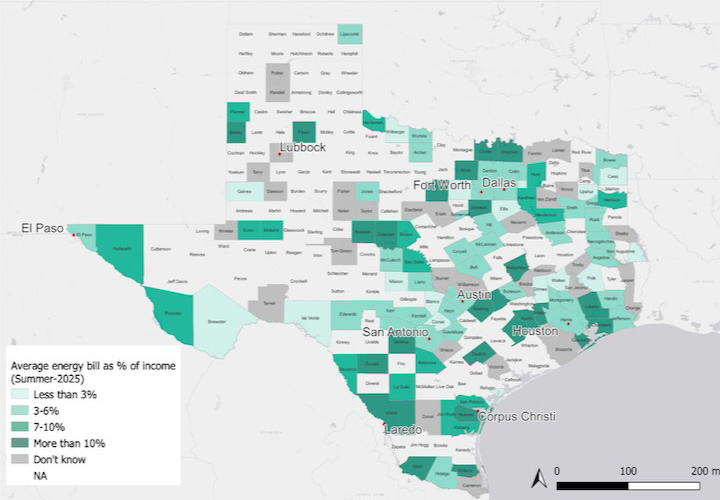Nearly 45% of Texas households pay over $200 a month on average for summer electricity, according to a new statewide survey from the University of Houston and Texas Southern University. (Credit Getty Images)
Key Takeaways
- Nearly one-third of Texans face high energy burdens, with low-income, minority, and rural communities disproportionately affected due to aging homes and inefficient infrastructure.
- Rising utility costs, grid upgrades, and new industrial demands like data centers threaten to worsen affordability and reliability across the state.
- While conservation and clean energy is a potential solution, public understanding is low and opinions are deeply divided along partisan lines, highlighting a need for broader education and policy focus on both supply and demand.
Texans face growing energy inequality as vulnerable communities, including those along the Gulf Coast, endure high energy burdens, rising utility costs and aging homes, according to a new survey by the University of Houston and Texas Southern University.
The statewide survey, conducted by UH’s Hobby School of Public Affairs and TSU’s Executive Master of Public Administration program in the Barbara Jordan-Mickey Leland School of Public Affairs, builds on earlier findings showing widespread anxiety over energy affordability and grid reliability. This has intensified as extreme weather, population growth and new energy demands strain the state’s energy system.
“One of the main things that we’ve been finding in our surveys is that people are concerned about cost of living, and energy costs have become an important component of that because they are expenses that households cannot easily reduce,” said Pablo Pinto, director of UH’s Center for Public Policy and Hobby School professor. “It’s no surprise these issues are front of mind for so many families.”
Nearly 45% of households pay over $200 a month on average for summer electricity. About one-third of Texans spend 7% or more of their income on energy — surpassing the high energy burden threshold of 6%.
Michael O. Adams, director of the Executive Master of Public Administration graduate program at TSU, noted that “the report highlights the growing concern among many Texans about their rising electricity bills, which are consuming a larger and larger share of their household income, especially during the peak-use summer months.”
Low-income, minority and rural communities are most affected, largely due to older housing, inefficient infrastructure and limited financial flexibility. Urban households, by comparison, benefit from more efficient housing and higher average incomes.

Energy burdens are highest in southern and western counties, where summer bills in some counties exceeded 11% of household income. And costs may worsen, as CenterPoint Energy announced plans to continue grid upgrades through 2028 — costs that will be passed on to consumers.
“In an already-strained system, an increase in demand from these new users, particularly data centers, is going to have an impact on consumers,” added Gail Buttorff, associate director of the CPP and research associate professor at the Hobby School.
The report’s other findings include:
- 39.1% reported difficulty paying energy bills over the past year, while 57.1% of respondents said they didn’t struggle.
- 19% reported having to choose between paying energy bills and other necessities like food, medicine or rent in the past year.
- Black (24.4%), Hispanic (29.8%) and other races/ethnicities (32.4%) were more likely to report difficulty paying energy bills versus white (13.1%) and Asian (11.7%) respondents.
- 58.8% of Texans rated their homes as “somewhat” or “very” energy efficient, but 19.1% considered them “somewhat” or “very” inefficient.
- 47% of respondents with household incomes less than $30,000 viewed their homes as “very” or “somewhat” efficient, compared to at least 71% of respondents from household incomes of $100,000 or higher.
The survey also looked at how electricity is used. During summer, top uses were refrigeration (74.7%), air conditioning (72.8%) and lighting (52.9%). However, priorities shift during disasters to refrigeration (58.4%), air conditioning (52.4%) and medical devices (42.6%).
“We found in our previous Texas Trends surveys that people heavily rely on electricity for preparedness and for mitigating the effects of natural disasters,” said Maria P. Perez Arguelles, lead researcher and research assistant professor at the Hobby School.
“One of the main things that we’ve been finding in our surveys is that people are concerned about cost of living, and energy costs have become an important component of that because they are expenses that households cannot easily reduce.”
— Pablo Pinto, UH’s Center for Public Policy
Opinions are divided along partisan lines on whether clean energy solutions would improve finances and energy efficiency — with 50.6% of Democrats and 18.9% of Republicans.
Pinto said public officials should encourage households to change energy habits, such as limiting major appliance usage during peak hours and unplugging devices that draw power even when not in use. These “idle loads” can account for up to 22% of household energy use in the U.S.
“It’s really hard to ask households to reduce consumption when you have these new and big actors whose electricity consumption are really high,” Pinto said. “But there’s always room for this idea of changing our consumption habits both as consumers and businesses to lower the burden on the system.”
The full report is available on the Hobby School website. The survey of 1,650 Texas registered voters was conducted between Sept. 19-Oct. 1 in English and Spanish. Previous reports explored voter preferences in the Texas U.S. Senate and state attorney general race, and views on partisan redistricting and immigration.
